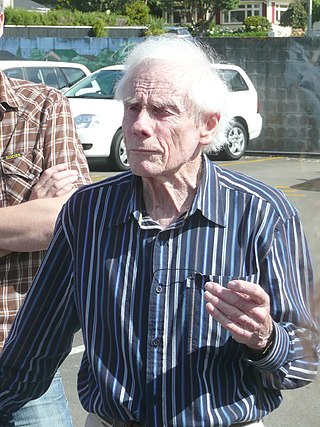
Wellington College of Education was established in 1888 with the purpose of educating teachers in New Zealand. It became the Faculty of Education of Victoria University of Wellington, formed from the School of Education of the University, and the Wellington College of Education on 1 January 2005.

William Gray Young was a New Zealand architect in the early 20th century, designing buildings such as Knox College in Dunedin, the Wellington railway station and Wellington's Elliott House. He was president of the New Zealand Institute of Architects from 1935 to 1937.

Sir Frederick Miles Warren was a New Zealand architect. He apprenticed under Cecil Wood before studying architecture at the University of Auckland, eventually working at the London County Council where he was exposed to British New Brutalism. Upon returning to Christchurch, and forming the practice Warren and Mahoney, he was instrumental in developing the "Christchurch School" of architecture, an intersection between the truth-to-materials and structural expression that characterised Brutalism, and the low-key, Scandinavian and Japanese commitment to "straightforwardness". He retired from Warren and Mahoney in 1994 but continued to consult as an architect and maintain his historic home and garden at Ohinetahi.
Architecture of New Zealand is the built environment of regions, cities and towns of New Zealand.
William Hildebrand Alington was a New Zealand modernist architect, whose work was awarded nationally, and recognised internationally. He was the husband of New Zealand historian Margaret Alington.

Stanley William Toomath was a New Zealand architect who practised mainly in Wellington. He was a founding member of the Architectural Group in Auckland in 1946, a life member of the Wellington Architectural Centre and a Fellow of the New Zealand Institute of Architects. Both the founding of the Group and the Architectural Centre were important factors in New Zealand's modernist architectural history.
James Albert Beard was a New Zealand architect, town planner, and landscape architect.
Roger Neville Walker is a New Zealand architect based in Wellington.
Margaret Hilda Alington was a New Zealand librarian, historian and author.
Gummer and Ford was an architectural firm founded in 1923 in Auckland, New Zealand, by William Gummer and Charles Reginald Ford. It was among the country's best-regarded architectural firm of the first half of the 20th century, designing numerous iconic buildings, including the former National Art Gallery and Dominion Museum in Wellington and the old Auckland Railway Station. Eighteen of the company's buildings have been registered as significant historic places by Heritage New Zealand. In 2006 an exhibition of their work was staged at The University of Auckland's Gus Fisher Gallery, and in 2007 the firm was described as 'the best architectural practice of all time in New Zealand'.
Francis Gordon Wilson was an Australian born, New Zealand architect. Wilson oversaw the design of New Zealand’s state housing programme from the 1930s onwards. He was the New Zealand Government Architect at the time of his death.
Architectus is a architectural firm based in Australia and New Zealand. The firm has over 700 staff with offices in Adelaide, Auckland, Brisbane, Christchurch, Melbourne, Sydney, Perth and Wellington.

The Hannah Playhouse is a theatre venue situated on the corner of Courtenay Place and Cambridge Terrace in central Wellington, New Zealand. The Hannah Playhouse was given by Sheilah Winn and named after her grandfather, Robert Hannah, a very successful businessman. It was carefully designed and built to house Downstage Theatre.

The New Zealand Institute of Architects Gold Medal is an award presented annually by the Te Kāhui Whaihanga New Zealand Institute of Architects (NZIA) to a New Zealand architect.

Petone Settlers Museum is a local history museum located in the Wellington Provincial Centennial Memorial, a historic building in Petone, Lower Hutt, New Zealand. The building was originally constructed to mark the Wellington province's centennial commemorations; the museum opened in the building in 1977. The building was extensively refurbished in 2016.
John Wilfred Manning was a New Zealand architect from Auckland. He is well known for a wide variety of designs including houses (particularly his own house at Stanley Bay, Cathcart House, and large commercial buildings. He was a fellow of the NZIA and was the recipient of its highest honour, the Gold Medal, in 2011.

Freyberg Pool is a public indoor swimming pool on Wellington Harbour, New Zealand. The main pool is 33 metres (108 ft) long. It is named for Bernard Freyberg, a World War I Victoria Cross recipient and Governor-General of New Zealand.
David John Mitchell was a New Zealand architect based in Auckland. He presented the 1984 television series The Elegant Shed, and co-authored the book of the same name. Mitchell was awarded the gold medal of the New Zealand Institute of Architects (NZIA) in 2005.
Peter John Bartlett was a New Zealand architect and professor of architectural design.

Laurence Jeremy Elder Salmond was a New Zealand conservation architect. He received the NZIA Gold Medal, the highest honour in New Zealand architecture, in 2018.









